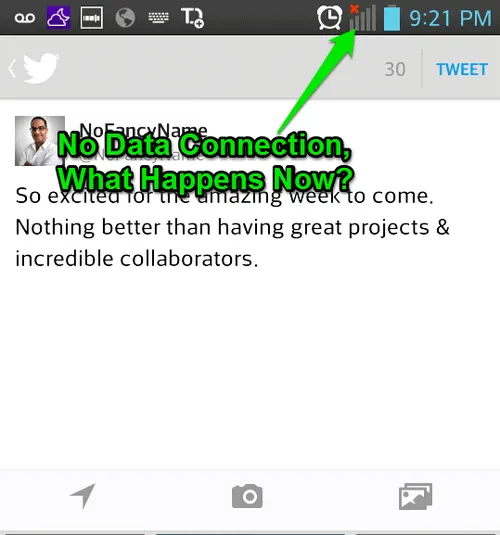· 3 min read Posted by Touchlab
Offline functionality is a no brainer (and how Twitter dropped the ball)


This is Part 2 of 3 in a series on Offline Connectivity.
Read Part 1: No Connection? Big Problem
Read Part 3:8 Tips For Building a Badass Offline App
————————————————————————————————————
As a startup founder, I get it: it’s a lot easier to compete in an existing market than one that doesn’t yet exist.
But as a developer, my goal is to build apps with the highest level of functionality possible.
In Touchlab’s grand vision for the future, android users will be able to interact fully with their favorite apps whether or not they’re connected to the Internet (except for features that specifically require a connection).
Twitter: just … why?
Twitter’s Android app is a prime example of what can go wrong when developers turn a blind eye to offline functionality. If your tweet doesn’t publish (say, because of a failed Internet connection), it automatically gets filed into a “drafts” folder. Where it goes to die, basically.
In addition to users being notified only once about their failed tweet, navigating to the “drafts” folder is like finding a needle in a haystack — a haystack positioned at the end of a 10-mile maze. From a developer standpoint, it’s really, really easy to program the app so that the tweet is automatically queued up when a connection returns, so I have no idea why Twitter doesn’t do this — it’s incredibly frustrating from a user’s perspective.

Take this example and multiply it by a bajillion, and you have the general sorry state of Android apps today.
UX to the rescue
Fortunately, the UX (user experience) community has done a great job recently of convincing people that the user’s perspective is actually important. A few years ago, UX was new and mysterious, but now companies, from Apple to hot new startups, pour big bucks into it because they understand that users respond to — and eventually adopt — apps and platforms that just work.
Although we generally think of UX as the practice of “figuring out where the buttons go,” the manner in which your app behaves in adverse conditions will increasingly be a part of the overall experience the farther we move away from the desk.
Very often, developers frame the offline debate as a black and white issue. It’s either “we support offline,” or “we don’t, because it would take a massive rewrite.” The reality, however, lies somewhere in the middle.
——————————————————————
Looking for a great team of focused Android experts to bring your idea to life? We do one thing: make Android apps. Keeping that focus means we can do things the right way. Let’s chat about your project, get in touch.
——————————————————————
Are you one of the best Android developers out there who likes solving problems, working on a small, agile team and building only the best solutions? Maybe we should talk, get in touch.